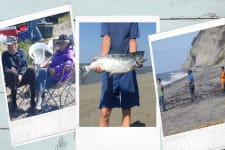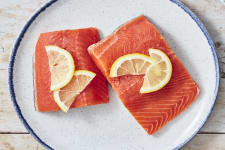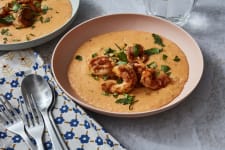Wild-caught salmon is a delicious, versatile fish that can be cooked in several ways. But determining the exact moment your salmon is done can be tricky. Keeping your wild salmon’s texture tender and moist is a delicate balance. If you rely solely on general cooking times or temperatures, you may end up with overcooked fillets and portions. To bring out its best flavor and texture, it’s important to monitor your salmon’s internal temperature closely.
Wild salmon reaches medium doneness when the flesh flakes easily. Yet, not all cooking methods are equally forgiving. The good news is that anyone can learn how to cook wild salmon to perfection, whether they like it moist and flaky or firm and well done. Here’s what you need to know about salmon internal temp and doneness.
Suggested Cooked Salmon Temps
The internal temp of salmon is the most reliable way to gauge its doneness. Here’s a quick breakdown of the cooked salmon temp you should aim for based on your texture preference:
- Medium-rare, moist and flaky: 120°F
- Medium, no longer translucent with firmer flakes: 125°F to 130°F
- Medium-well, slightly dry: 130°F to 140°F
- Well-done, very dry and completely cooked through: 145°F
How Long to Cook Salmon at Different Temperatures
Cooking times for wild salmon depend on the method and temperature. Use the guide below to help you hit your desired internal temp for salmon without overcooking.
- 300°F: 15 to 20 minutes
- 325°F: 12 to 18 minutes
- 350°F: 10 to 12 minutes
- 375°F: 8 to 10 minutes
- 400°F: 7 to 9 minutes
- 425°F: 6 to 8 minutes
How Long to Broil or Grill Salmon
- High broiler: 4 to 6 minutes
- Hot grill: 4 to 6 minutes
Wild vs. Farmed Salmon Cooking Times
If you blindly follow some fish recipes on the internet, you’ll learn the hard way that you can easily overcook wild salmon. That’s because many cooked salmon temperatures and times are designed around farmed salmon. Wild salmon, unlike the fattier farmed salmon, cooks faster due to its lower fat content. Make sure to pay attention to the correct cooking times and temps for wild and farmed salmon for the best outcome.
Additional Tips to Tell That Salmon Is Done
To keep your salmon at the perfect cooked salmon temp, here are some tried-and-true methods you can use:
Use a Timer
Even with foolproof recipes and specific cooking times, we all get distracted and forget to take our fish off the grill or out of the oven. When given a range of cook times, set the timer for the shortest cook time. It's always better to err on the side of underdone. Then, check its doneness and adjust the cooking time as needed.
Use Your Eyes
Keep an eye on the fish as it cooks. When salmon is nearly done — especially when you're cooking with very hot cooking methods — a white protein called albumin will start collecting on the surface of the fish.
Use a Fork
You can use a fork to break off a small bite of fish. If it flakes nicely, it’s done. If it’s hard to break off and raw inside, it needs more time. And if the texture seems tough and dry, it’s overcooked.
Assume It Will Finish Cooking on the Plate
Even after you remove your fish from the oven or stovetop, it will continue cooking for a few minutes. The internal temperature of the fish will temporarily increase even though the exterior has begun cooling. That’s why leaving the center a bit translucent helps ensure excellent texture when you’re ready to serve.
Cooking wild-caught salmon to perfection is all about finding the ideal balance of time and salmon temperature. By following these tips, you’ll achieve tender, flavorful fillets every time.
Note: Consuming raw or undercooked meats, poultry, seafood, shellfish, or eggs may increase your risk of foodborne illness, especially if you have a certain medical condition. The FDA recommends an internal temperature of 145°F for cooked fish.






